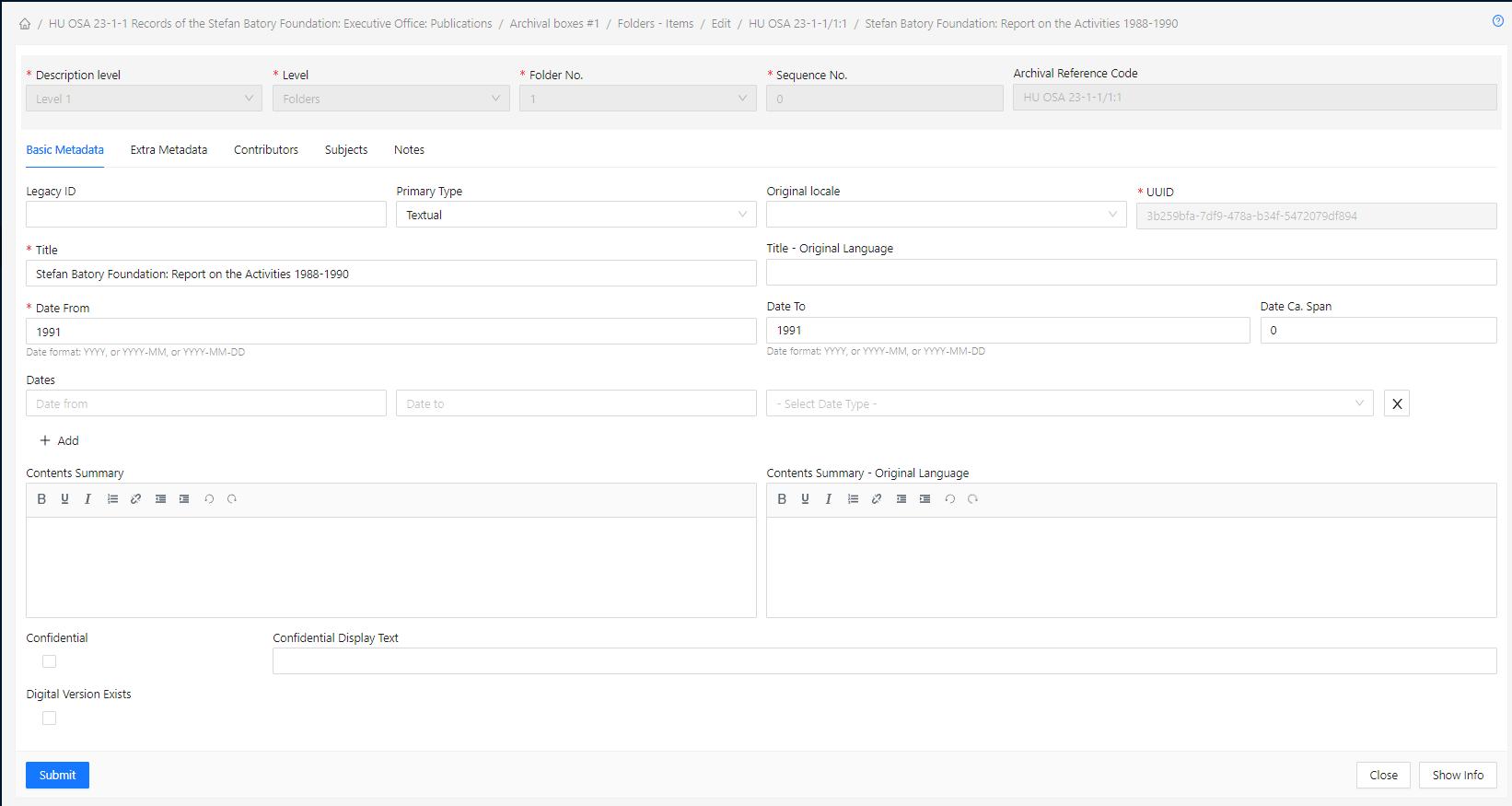Basic Metadata Tab
Description Level [Mandatory]
Set the level of description from the drop-down list. Folders can contain items. See Folder/Item switch.
Level 1 number [Mandatory]
An automated value indicating the number of the current container.
Level (Folder/Item) [Mandatory]
From the drop-down list, select whether the description applies to an item or a folder
UUID [Mandatory]
Automated value.
Legacy ID
This field contains the corresponding legacy ID of the unit if exists.
Primary type [Mandatory]
Select from the drop-down list the type of the described item (primary types: Audio, Electronic Record, Still Image, Textual, Video).
Archival reference code
Automated value.
Original locale
If the description is chosen to be bilingual, this drop-down list is used to select the original (non-English) language of metadata. Read more on Languages and Multilingualism.
Title [Mandatory]
Standards Reference: ISAD(G) 3.1.2 Format: Refer to OSA Naming Convention, Appendix E of the OSA Cataloging Manual Purpose: To name the unit of description. Rule: Generally as inscribed on the material itself or assigned by the cataloguer using data from material and collection. Should be unique among the items of the archival series. For archival material, most titles can be considered inscribed, unless a title is wholly created by the cataloguer and not based on evidence from the material or archival collection. If appropriate, abridge a long formal title, but only if this can be done without loss of essential information. For supplied titles, one may include, for example, the name of the author of the document and a term indicating the form of the material comprising the unit of description and, where appropriate, a phrase reflecting function, activity, subject, location, or theme. Supplied titles are in square brackets. Example: [Foreign Correspondence: France]
Title - Original language
If the description of the archival unit is chosen to be bilingual, this field contains the title in the original (non-English) language. Read more on Languages and Multilingualism.
Date from, Date to, Date ca span, Dates
Standards Reference: ISAD(G) 3.1.3 Format: YYYY or YYYY-MM or YYYY-MM-DD Circa Year Purpose: To identify and record the date(s) of the unit of description. Rule: Record the date(s) when the folder/item was created. Assign the year with the month or exact day, when applicable. Can be the date the item was created, collected, or published/distributed, when applicable. Details can be given in Administrative History. Add additional date information using the Add+ button, as required. Example: 1985 circa year: 5 (The document has been created presumably between 1980 and 1990)
Contents summary
Format: Free text Purpose: Use this section to include a summary of the item. This can be an explanation of the subject matter of the item or a description of its form. For visual materials, or even the context in which the item was created. This may be given by the cataloguer or taken from the source or other reference material. When the source or reference material is used, this should be noted in the Collection Description and/or in Additional Note and/or in the Publication Fields.
Contents summary - Original language
If the description of the unit is chosen to be bilingual, this field should contain the summary of the content in the original (non-English) language. Read more on Languages and Multilingualism.
Confidential checkbox
Check the checkbox if the described material is confidential. If checked, instead of a full FA record, a confidential display text will appear in the catalog (please see below).
Confidential display text
Input the confidential display text. This will serve as a placeholder in the catalog for confidential documents.
Digital version exists checkbox
Check the checkbox if a digital version also exists of the described material.


